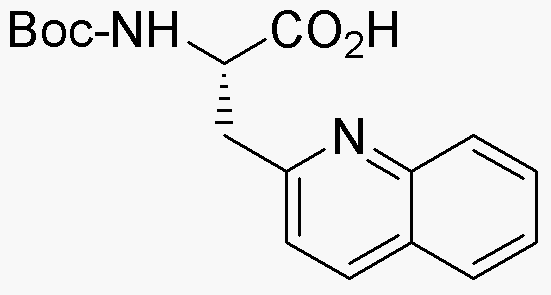Boc-3-(2'-quinolyl)-L-alanine is widely utilized in research focused on:
- Peptide Synthesis: This compound serves as a key building block in the synthesis of peptides, particularly those that require specific structural features for biological activity. Its protective Boc group allows for selective reactions, enhancing the efficiency of peptide assembly.
- Drug Development: It plays a significant role in medicinal chemistry, particularly in the design of new pharmaceuticals targeting various diseases. The quinoline moiety can enhance the biological properties of drug candidates, making them more effective.
- Biochemical Research: Researchers utilize this compound to study protein interactions and enzyme activities, providing insights into cellular mechanisms and potential therapeutic targets.
- Analytical Chemistry: The compound is employed in various analytical techniques, including chromatography and mass spectrometry, to identify and quantify biological samples, ensuring accurate results in research and quality control.
- Material Science: Its unique properties make it suitable for developing advanced materials, such as sensors and coatings, which can be tailored for specific applications in electronics and environmental monitoring.
General Information
Properties
Safety and Regulations
Applications
Boc-3-(2'-quinolyl)-L-alanine is widely utilized in research focused on:
- Peptide Synthesis: This compound serves as a key building block in the synthesis of peptides, particularly those that require specific structural features for biological activity. Its protective Boc group allows for selective reactions, enhancing the efficiency of peptide assembly.
- Drug Development: It plays a significant role in medicinal chemistry, particularly in the design of new pharmaceuticals targeting various diseases. The quinoline moiety can enhance the biological properties of drug candidates, making them more effective.
- Biochemical Research: Researchers utilize this compound to study protein interactions and enzyme activities, providing insights into cellular mechanisms and potential therapeutic targets.
- Analytical Chemistry: The compound is employed in various analytical techniques, including chromatography and mass spectrometry, to identify and quantify biological samples, ensuring accurate results in research and quality control.
- Material Science: Its unique properties make it suitable for developing advanced materials, such as sensors and coatings, which can be tailored for specific applications in electronics and environmental monitoring.
Documents
Safety Data Sheets (SDS)
The SDS provides comprehensive safety information on handling, storage, and disposal of the product.
Product Specification (PS)
The PS provides a comprehensive breakdown of the product’s properties, including chemical composition, physical state, purity, and storage requirements. It also details acceptable quality ranges and the product's intended applications.
Certificates of Analysis (COA)
Search for Certificates of Analysis (COA) by entering the products Lot Number. Lot and Batch Numbers can be found on a product’s label following the words ‘Lot’ or ‘Batch’.
*Catalog Number
*Lot Number
Certificates Of Origin (COO)
This COO confirms the country where the product was manufactured, and also details the materials and components used in it and whether it is derived from natural, synthetic, or other specific sources. This certificate may be required for customs, trade, and regulatory compliance.
*Catalog Number
*Lot Number
Safety Data Sheets (SDS)
The SDS provides comprehensive safety information on handling, storage, and disposal of the product.
DownloadProduct Specification (PS)
The PS provides a comprehensive breakdown of the product’s properties, including chemical composition, physical state, purity, and storage requirements. It also details acceptable quality ranges and the product's intended applications.
DownloadCertificates of Analysis (COA)
Search for Certificates of Analysis (COA) by entering the products Lot Number. Lot and Batch Numbers can be found on a product’s label following the words ‘Lot’ or ‘Batch’.
*Catalog Number
*Lot Number
Certificates Of Origin (COO)
This COO confirms the country where the product was manufactured, and also details the materials and components used in it and whether it is derived from natural, synthetic, or other specific sources. This certificate may be required for customs, trade, and regulatory compliance.


